DODGE CALIBER SRT 2008 1.G Service Manual
Manufacturer: DODGE, Model Year: 2008, Model line: CALIBER SRT, Model: DODGE CALIBER SRT 2008 1.GPages: 373, PDF Size: 3 MB
Page 41 of 373
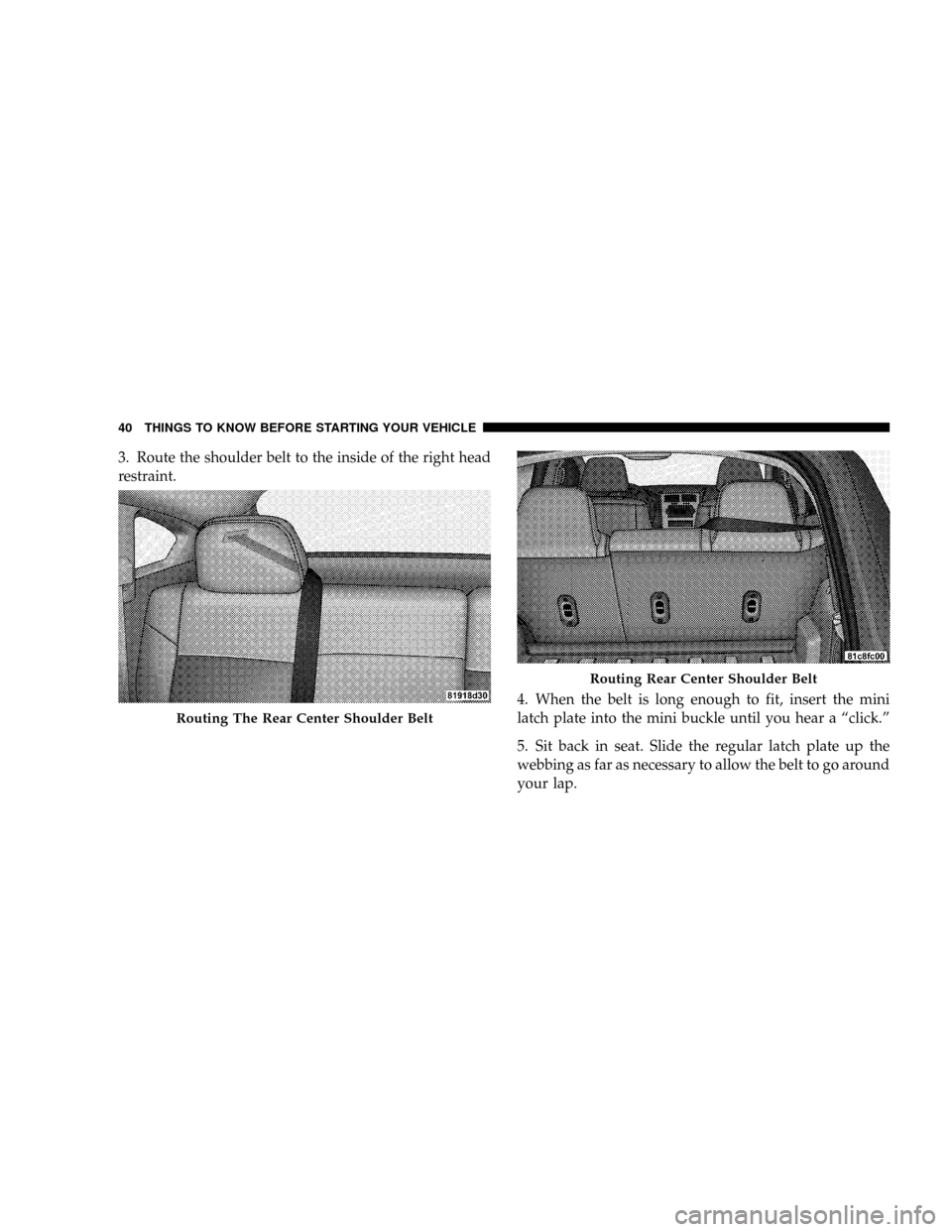
3. Route the shoulder belt to the inside of the right head
restraint.
4. When the belt is long enough to fit, insert the mini
latch plate into the mini buckle until you hear a ªclick.º
5. Sit back in seat. Slide the regular latch plate up the
webbing as far as necessary to allow the belt to go around
your lap.
Routing The Rear Center Shoulder Belt
Routing Rear Center Shoulder Belt
40 THINGS TO KNOW BEFORE STARTING YOUR VEHICLE
Page 42 of 373

6. When the belt is long enough to fit, insert the latch
plate into the buckle until you hear a ªclick.º
7. Position the lap belt across your thighs, below your
abdomen. To remove slack in the lap belt portion, pull upon the shoulder belt. To loosen the lap belt if it is too tight,
pull on the lap belt. A snug belt reduces the risk of sliding
under the belt in a collision.
8. Position the shoulder belt on your chest so that it is
comfortable and not resting on your neck. The retractor
will withdraw any slack in the belt.
Connecting Mini Latch to Buckle
Rear Center Seat Belt Buckled
THINGS TO KNOW BEFORE STARTING YOUR VEHICLE 41
2
Page 43 of 373
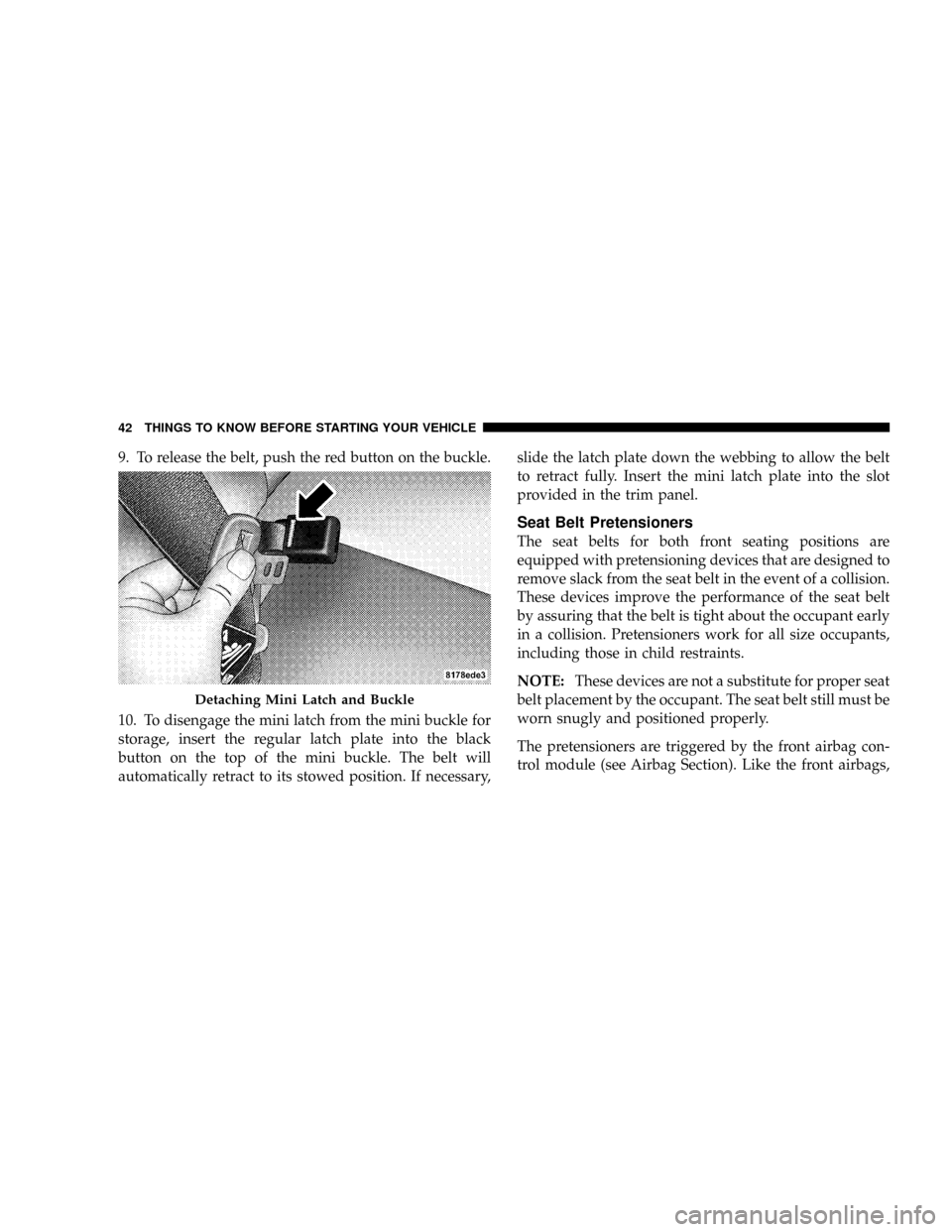
9. To release the belt, push the red button on the buckle.
10. To disengage the mini latch from the mini buckle for
storage, insert the regular latch plate into the black
button on the top of the mini buckle. The belt will
automatically retract to its stowed position. If necessary,slide the latch plate down the webbing to allow the belt
to retract fully. Insert the mini latch plate into the slot
provided in the trim panel.
Seat Belt Pretensioners
The seat belts for both front seating positions are
equipped with pretensioning devices that are designed to
remove slack from the seat belt in the event of a collision.
These devices improve the performance of the seat belt
by assuring that the belt is tight about the occupant early
in a collision. Pretensioners work for all size occupants,
including those in child restraints.
NOTE:These devices are not a substitute for proper seat
belt placement by the occupant. The seat belt still must be
worn snugly and positioned properly.
The pretensioners are triggered by the front airbag con-
trol module (see Airbag Section). Like the front airbags,
Detaching Mini Latch and Buckle
42 THINGS TO KNOW BEFORE STARTING YOUR VEHICLE
Page 44 of 373

the pretensioners are single use items. After a collision
that is severe enough to deploy the airbags and preten-
sioners, both must be replaced.
Enhanced Driver and Seat Belt Reminder System
(BeltAlert)
If the driver's seat belt has not been buckled within 60
seconds of starting the vehicle and if the vehicle speed is
greater than 5 mph (8 km/h), the Enhanced Warning
System (BeltAlert) will alert the driver to buckle their seat
belt. The driver should also instruct all other occupants to
buckle their seat belts. Once the warning is triggered, the
Enhanced Warning System (BeltAlert) will continue to
chime and flash the Seat Belt Warning Light for 96
seconds or until the driver's seat belt is buckled. The
Enhanced Warning System (BeltAlert) will be reactivated
if the driver's seat belt is unbuckled for more than 10
seconds and the vehicle speed is greater than 5 mph (8
km/h).The Enhanced Warning System (BeltAlert) can be en-
abled or disabled by your authorized dealer or by
following these steps:
NOTE:The following steps must occur within the first
60 seconds of the ignition switch being turned to the ON
or START position. DaimlerChrysler Corporation does
not recommend deactivating the Enhanced Warning Sys-
tem (BeltAlert).
1. Turn the ignition switch to the LOCK position and
buckle the driver or front passenger seat belt.
2. Turn the ignition switch to the ON position and wait
for the Seat Belt Warning Light to turn off.
3. Within 60 seconds of turning the ignition switch to the
ON position, unbuckle and then re-buckle the driver or
front passenger seat belt at least three times within 10
seconds, ending with the seat belt buckled.
THINGS TO KNOW BEFORE STARTING YOUR VEHICLE 43
2
Page 45 of 373
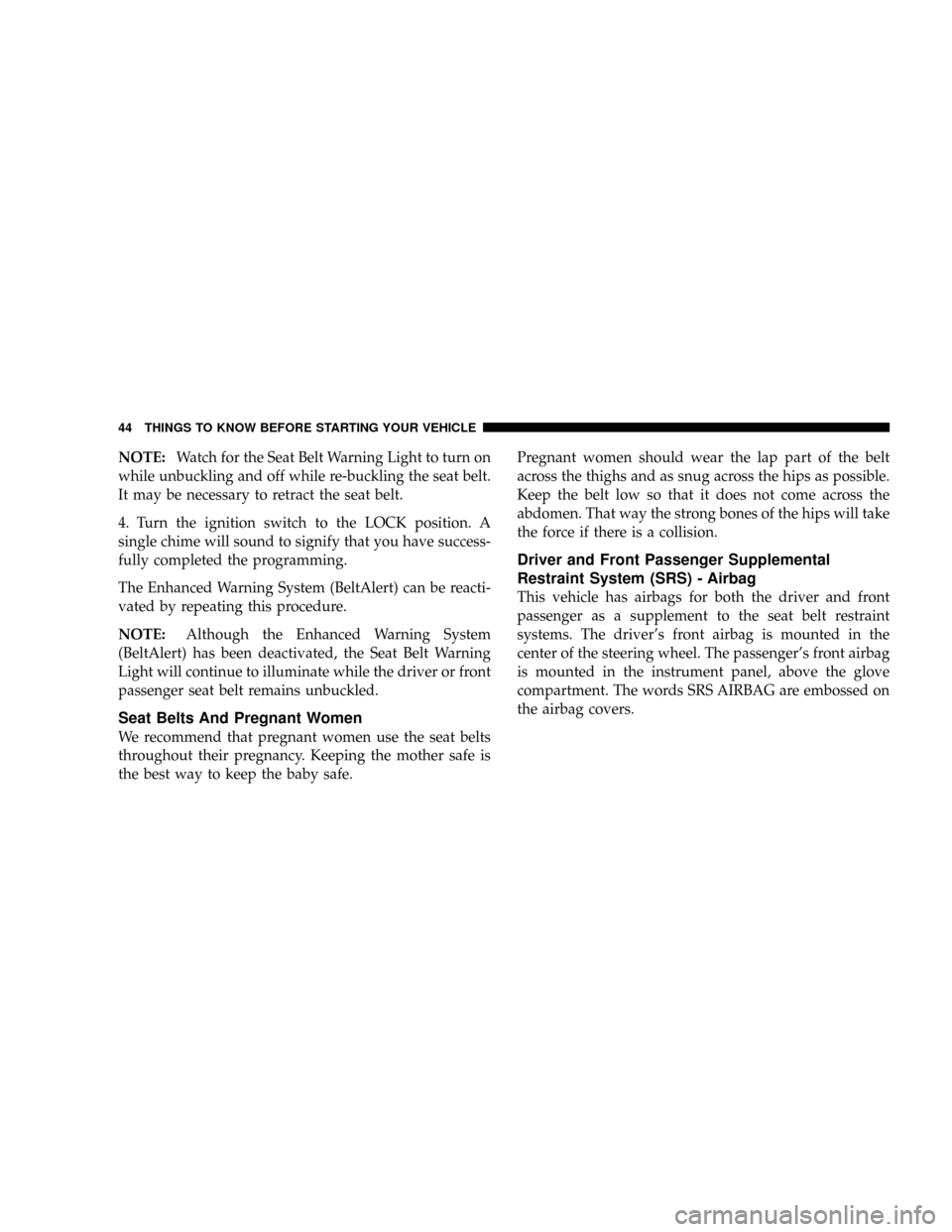
NOTE:Watch for the Seat Belt Warning Light to turn on
while unbuckling and off while re-buckling the seat belt.
It may be necessary to retract the seat belt.
4. Turn the ignition switch to the LOCK position. A
single chime will sound to signify that you have success-
fully completed the programming.
The Enhanced Warning System (BeltAlert) can be reacti-
vated by repeating this procedure.
NOTE:Although the Enhanced Warning System
(BeltAlert) has been deactivated, the Seat Belt Warning
Light will continue to illuminate while the driver or front
passenger seat belt remains unbuckled.
Seat Belts And Pregnant Women
We recommend that pregnant women use the seat belts
throughout their pregnancy. Keeping the mother safe is
the best way to keep the baby safe.Pregnant women should wear the lap part of the belt
across the thighs and as snug across the hips as possible.
Keep the belt low so that it does not come across the
abdomen. That way the strong bones of the hips will take
the force if there is a collision.
Driver and Front Passenger Supplemental
Restraint System (SRS) - Airbag
This vehicle has airbags for both the driver and front
passenger as a supplement to the seat belt restraint
systems. The driver's front airbag is mounted in the
center of the steering wheel. The passenger's front airbag
is mounted in the instrument panel, above the glove
compartment. The words SRS AIRBAG are embossed on
the airbag covers.
44 THINGS TO KNOW BEFORE STARTING YOUR VEHICLE
Page 46 of 373
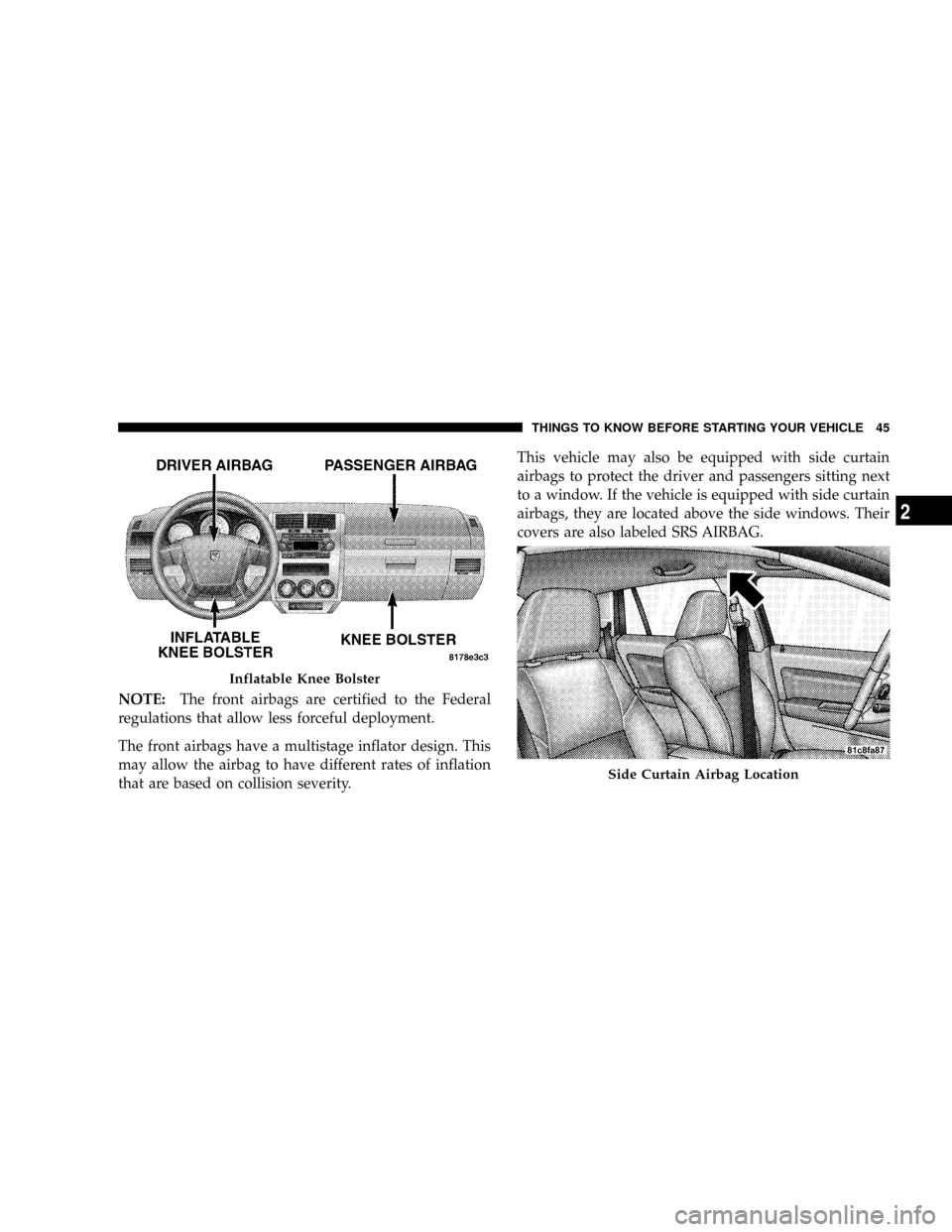
NOTE:The front airbags are certified to the Federal
regulations that allow less forceful deployment.
The front airbags have a multistage inflator design. This
may allow the airbag to have different rates of inflation
that are based on collision severity.This vehicle may also be equipped with side curtain
airbags to protect the driver and passengers sitting next
to a window. If the vehicle is equipped with side curtain
airbags, they are located above the side windows. Their
covers are also labeled SRS AIRBAG.
Inflatable Knee Bolster
Side Curtain Airbag Location
THINGS TO KNOW BEFORE STARTING YOUR VEHICLE 45
2
Page 47 of 373
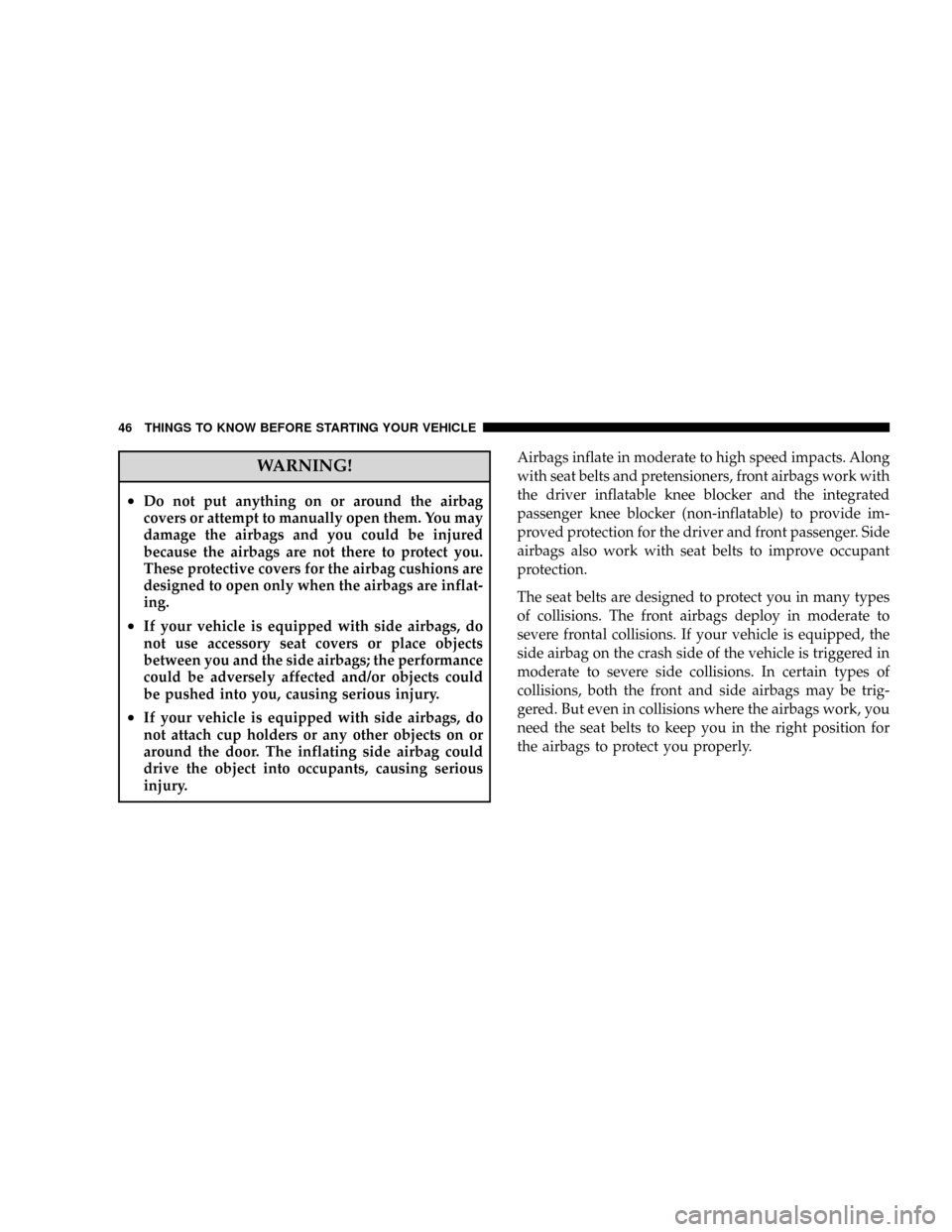
WARNING!
²Do not put anything on or around the airbag
covers or attempt to manually open them. You may
damage the airbags and you could be injured
because the airbags are not there to protect you.
These protective covers for the airbag cushions are
designed to open only when the airbags are inflat-
ing.
²If your vehicle is equipped with side airbags, do
not use accessory seat covers or place objects
between you and the side airbags; the performance
could be adversely affected and/or objects could
be pushed into you, causing serious injury.
²If your vehicle is equipped with side airbags, do
not attach cup holders or any other objects on or
around the door. The inflating side airbag could
drive the object into occupants, causing serious
injury.Airbags inflate in moderate to high speed impacts. Along
with seat belts and pretensioners, front airbags work with
the driver inflatable knee blocker and the integrated
passenger knee blocker (non-inflatable) to provide im-
proved protection for the driver and front passenger. Side
airbags also work with seat belts to improve occupant
protection.
The seat belts are designed to protect you in many types
of collisions. The front airbags deploy in moderate to
severe frontal collisions. If your vehicle is equipped, the
side airbag on the crash side of the vehicle is triggered in
moderate to severe side collisions. In certain types of
collisions, both the front and side airbags may be trig-
gered. But even in collisions where the airbags work, you
need the seat belts to keep you in the right position for
the airbags to protect you properly.
46 THINGS TO KNOW BEFORE STARTING YOUR VEHICLE
Page 48 of 373
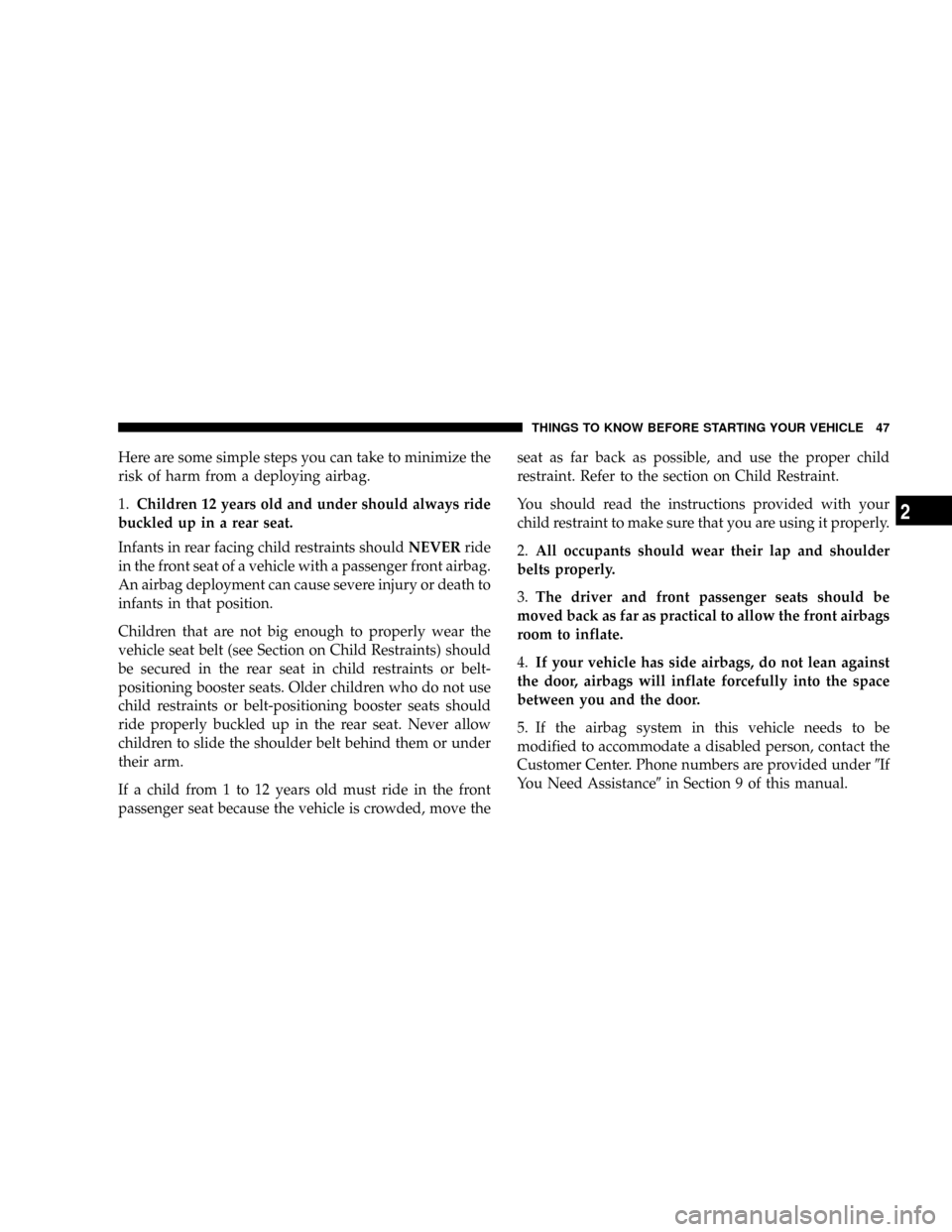
Here are some simple steps you can take to minimize the
risk of harm from a deploying airbag.
1.Children 12 years old and under should always ride
buckled up in a rear seat.
Infants in rear facing child restraints shouldNEVERride
in the front seat of a vehicle with a passenger front airbag.
An airbag deployment can cause severe injury or death to
infants in that position.
Children that are not big enough to properly wear the
vehicle seat belt (see Section on Child Restraints) should
be secured in the rear seat in child restraints or belt-
positioning booster seats. Older children who do not use
child restraints or belt-positioning booster seats should
ride properly buckled up in the rear seat. Never allow
children to slide the shoulder belt behind them or under
their arm.
If a child from 1 to 12 years old must ride in the front
passenger seat because the vehicle is crowded, move theseat as far back as possible, and use the proper child
restraint. Refer to the section on Child Restraint.
You should read the instructions provided with your
child restraint to make sure that you are using it properly.
2.All occupants should wear their lap and shoulder
belts properly.
3.The driver and front passenger seats should be
moved back as far as practical to allow the front airbags
room to inflate.
4.If your vehicle has side airbags, do not lean against
the door, airbags will inflate forcefully into the space
between you and the door.
5. If the airbag system in this vehicle needs to be
modified to accommodate a disabled person, contact the
Customer Center. Phone numbers are provided under9If
You Need Assistance9in Section 9 of this manual.
THINGS TO KNOW BEFORE STARTING YOUR VEHICLE 47
2
Page 49 of 373
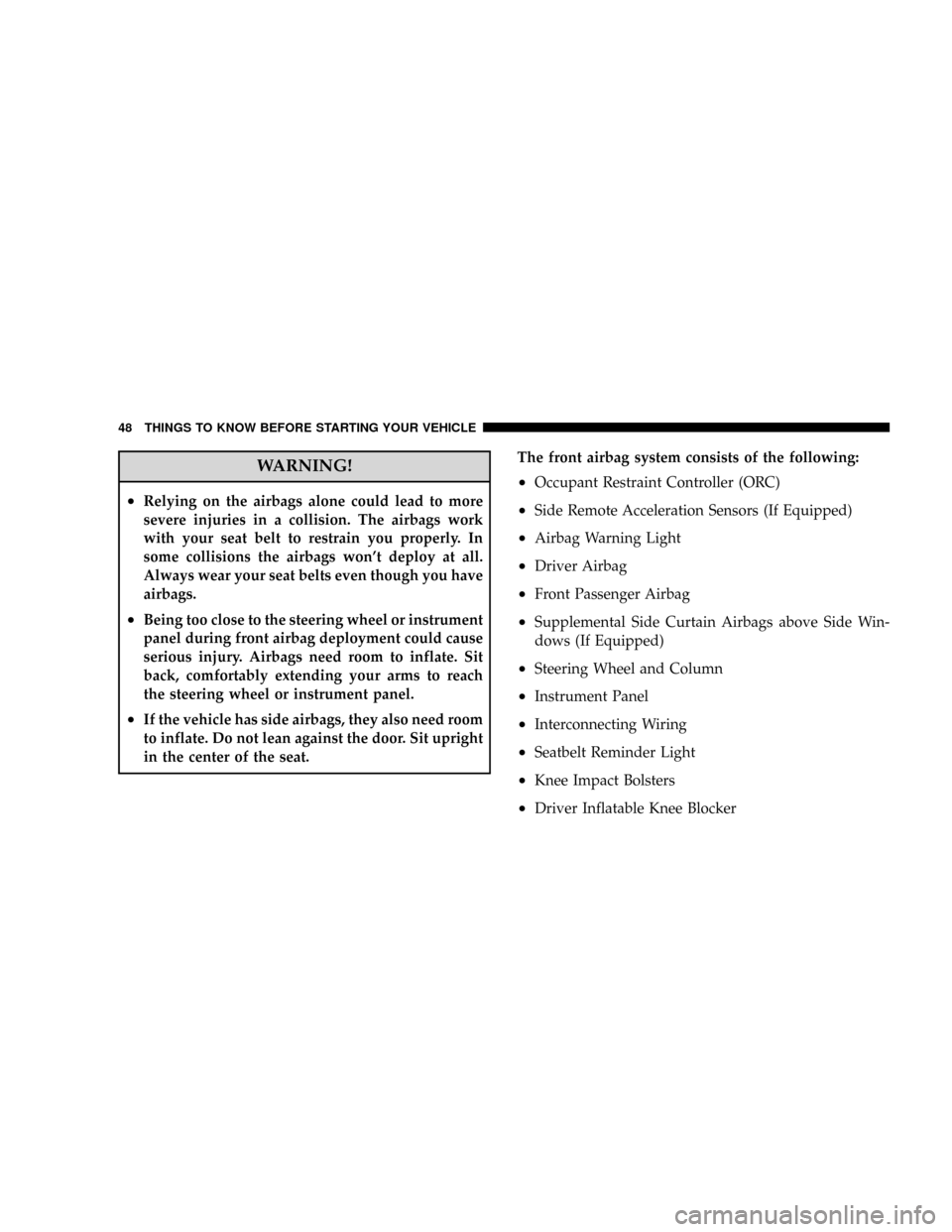
WARNING!
²Relying on the airbags alone could lead to more
severe injuries in a collision. The airbags work
with your seat belt to restrain you properly. In
some collisions the airbags won't deploy at all.
Always wear your seat belts even though you have
airbags.
²Being too close to the steering wheel or instrument
panel during front airbag deployment could cause
serious injury. Airbags need room to inflate. Sit
back, comfortably extending your arms to reach
the steering wheel or instrument panel.
²If the vehicle has side airbags, they also need room
to inflate. Do not lean against the door. Sit upright
in the center of the seat.The front airbag system consists of the following:
²Occupant Restraint Controller (ORC)
²Side Remote Acceleration Sensors (If Equipped)
²Airbag Warning Light
²Driver Airbag
²Front Passenger Airbag
²Supplemental Side Curtain Airbags above Side Win-
dows (If Equipped)
²Steering Wheel and Column
²Instrument Panel
²Interconnecting Wiring
²Seatbelt Reminder Light
²Knee Impact Bolsters
²Driver Inflatable Knee Blocker
48 THINGS TO KNOW BEFORE STARTING YOUR VEHICLE
Page 50 of 373
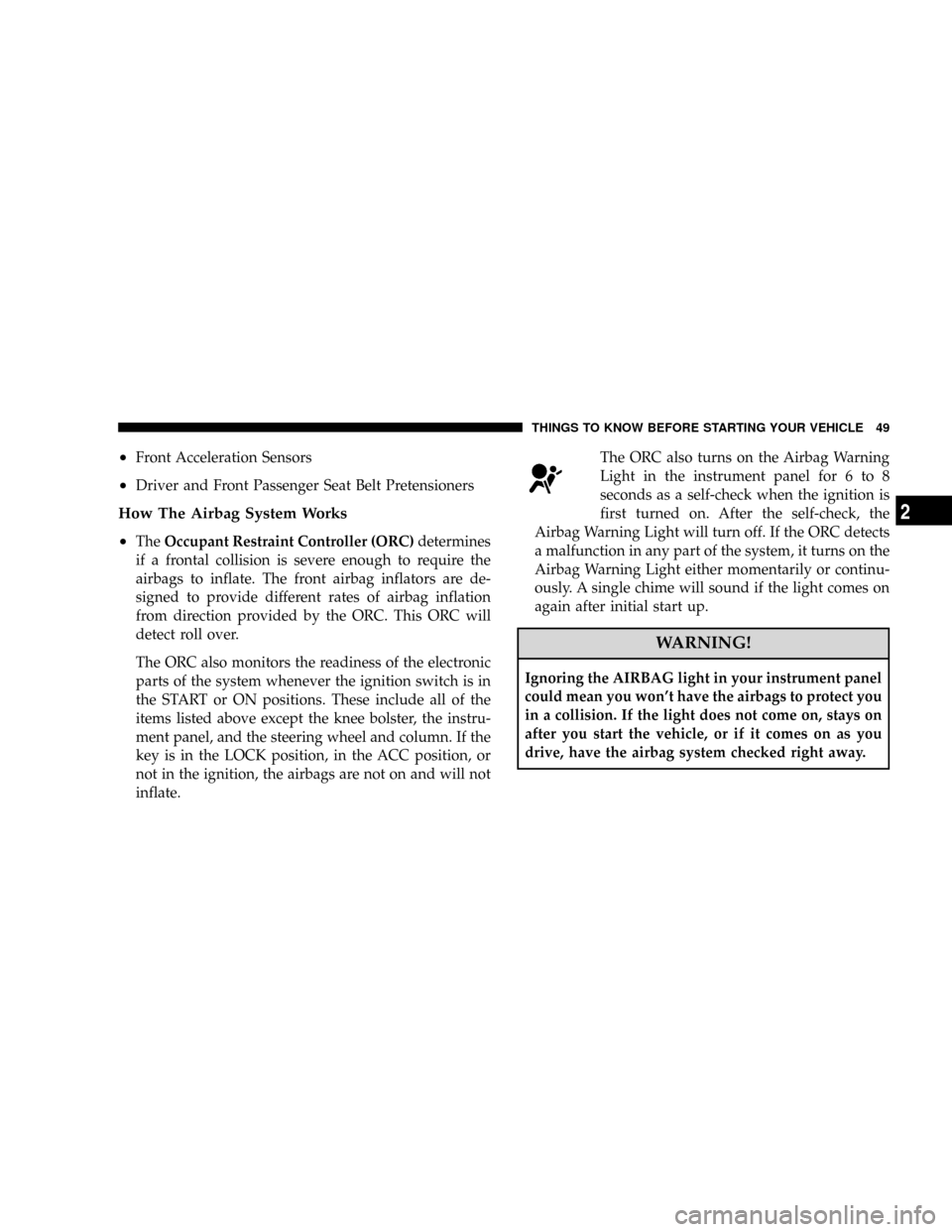
²Front Acceleration Sensors
²Driver and Front Passenger Seat Belt Pretensioners
How The Airbag System Works
²
TheOccupant Restraint Controller (ORC)determines
if a frontal collision is severe enough to require the
airbags to inflate. The front airbag inflators are de-
signed to provide different rates of airbag inflation
from direction provided by the ORC. This ORC will
detect roll over.
The ORC also monitors the readiness of the electronic
parts of the system whenever the ignition switch is in
the START or ON positions. These include all of the
items listed above except the knee bolster, the instru-
ment panel, and the steering wheel and column. If the
key is in the LOCK position, in the ACC position, or
not in the ignition, the airbags are not on and will not
inflate.The ORC also turns on the Airbag Warning
Light in the instrument panel for 6 to 8
seconds as a self-check when the ignition is
first turned on. After the self-check, the
Airbag Warning Light will turn off. If the ORC detects
a malfunction in any part of the system, it turns on the
Airbag Warning Light either momentarily or continu-
ously. A single chime will sound if the light comes on
again after initial start up.
WARNING!
Ignoring the AIRBAG light in your instrument panel
could mean you won't have the airbags to protect you
in a collision. If the light does not come on, stays on
after you start the vehicle, or if it comes on as you
drive, have the airbag system checked right away.
THINGS TO KNOW BEFORE STARTING YOUR VEHICLE 49
2